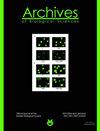金属氧化物纳米颗粒对河滨手蛾(双翅目,手蛾科)组织病理学的影响
IF 0.8
4区 生物学
Q4 BIOLOGY
引用次数: 3
摘要
随着金属基纳米材料产量的增加,纳米级产品及其副产品进入水生环境是不可避免的。就全球产量而言,最丰富的纳米氧化物是TiO2、CeO2和Fe3O4纳米颗粒。河滨Chironomus riparius通常用于生态毒理学评估,并定义其组织病理学生物标志物,以展示所测试纳米颗粒的毒性作用,这将有助于更好地理解纳米材料在水生生态系统中积累的后果。在这项研究中,提供了一个组织学描述的消化和排泄系统,以及脂肪体结构的河岸夜蛾幼虫。此外,根据获得的器官组织病理学改变,确定了纳米氧化物毒性的潜在组织学生物标志物。纳米fe3o4处理的中肠I区上皮细胞以及纳米fe3o4和纳米ceo2处理的马氏小管中可见空泡化。暴露于纳米tio2的幼虫显示出脂肪体和中肠II区组织结构的改变。此外,暴露于纳米fe3o4的组肠刷边界缩短。这些结果揭示了这些器官的高敏感性,可以作为组织病理学评估的生物标志物,从而导致现有生态毒理学研究方法的进一步改进。本文章由计算机程序翻译,如有差异,请以英文原文为准。
Histopathology of Chironomus riparius (Diptera, Chironomidae) exposed to metal oxide nanoparticles
As the production of metal-based nanomaterials increases, it is inevitable that nano-scale products and byproducts will enter the aquatic environment. In terms of global production, the most abundant nano-oxides are TiO2, CeO2 and Fe3O4 nanoparticles. Chironomus riparius is commonly used for ecotoxicological assessment and defining its histopathological biomarkers that showcase the toxic effect of tested nanoparticles should lead to a better understanding of the consequences of nanomaterial accumulation in aquatic ecosystems. In this study, a histological description of the digestive and excretory systems as well as the fat body structure of C. riparius larvae is provided. In addition, potential histological biomarkers of nano-oxide toxicity were determined based on the obtained histopathological alterations in organs. Vacuolization was observed in epithelial cells of midgut region I that were treated with nano-Fe3O4 as well as in Malpighian tubules treated with nano-Fe3O4 and nano-CeO2. Larvae exposed to nano-TiO2 showed alterations in the fat body and midgut region II tissue architecture. Additionally, shortening of the intestinal brush border was determined in groups exposed to nano-Fe3O4. These results reveal the high sensitivity of these organs, which can be used as biomarkers in histopathological assessment and therefore lead to further improvement of existing methodology in ecotoxicological studies.
求助全文
通过发布文献求助,成功后即可免费获取论文全文。
去求助
来源期刊
CiteScore
1.40
自引率
0.00%
发文量
25
审稿时长
3-8 weeks
期刊介绍:
The Archives of Biological Sciences is a multidisciplinary journal that covers original research in a wide range of subjects in life science, including biology, ecology, human biology and biomedical research.
The Archives of Biological Sciences features articles in genetics, botany and zoology (including higher and lower terrestrial and aquatic plants and animals, prokaryote biology, algology, mycology, entomology, etc.); biological systematics; evolution; biochemistry, molecular and cell biology, including all aspects of normal cell functioning, from embryonic to differentiated tissues and in different pathological states; physiology, including chronobiology, thermal biology, cryobiology; radiobiology; neurobiology; immunology, including human immunology; human biology, including the biological basis of specific human pathologies and disease management.

 求助内容:
求助内容: 应助结果提醒方式:
应助结果提醒方式:


